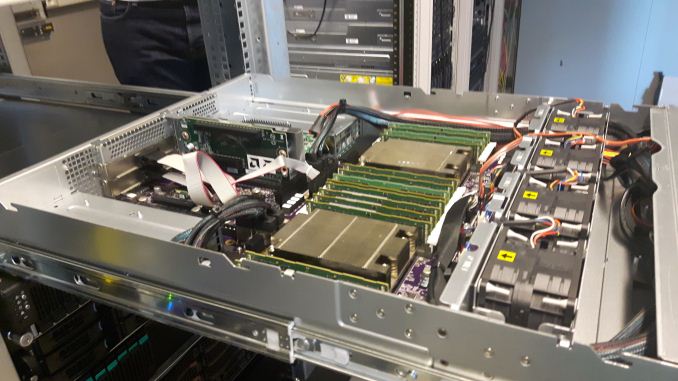Intel's Xeon Cascade Lake vs. NVIDIA Turing: An Analysis in AI
by Johan De Gelas on July 29, 2019 8:30 AM ESTTesting Notes
As the market stands, it is clear that alongside AMD and ARM, NVIDIA's professional offerings are a real threat to Intel's dominance in the datacenter and beyond. So for our testing today, we're going to focus on machine learning, and see just how Intel's new DL Boosted wares fare against the competition in the ML space.
On the Intel side of matters, of course, we're looking at the company's new Cascade Lake Xeon Scalable CPUs. The company provided two of their 28 core models, with the 165 Watt Xeon Platinum 8176, as well as the even faster 205 Watt Xeon Platinum 8280.
As for Cascade Lake's GPU competition, we've tapped NVIDIA's latest "Turing" Titan RTX card. While these aren't truly datacenter cards, the fact that they're based Turing means that they offer NVIDIA's very latest features. At the university that I work for, our deep learning researchers use these GPUs for training AI models as the Titan cards are affordable and have a lot of GPU memory available.
As an added bonus, Titan RTX cards can be used for both training (Hybrid FP32/16) as inference (FP16 and INT8). The current Tesla is still based on NVIDIA's Volta architecture, which does not have INT8 available for inference.
Finally, not to be excluded, we've also included AMD's first-generation EPYC platform in all of our testing. AMD doesn't have a hardware strategy quite like Intel – or specific instructions like VNNI – but as of late the company has offered all sorts of surprises.
Benchmark Configuration and Methodology
All of our testing was conducted on Ubuntu Server 18.04 LTS. You will notice that the DRAM capacity varies among our server configurations. This is of course a result of the fact that Xeons have access to six memory channels while EPYC CPUs have eight channels. As far as we know, all of our tests fit in 128 GB, so DRAM capacity should not have much influence on performance. But it will have a impact on total energy consumption, which we will discuss.
Last but not least, we want to note how the performance graphs have been color-coded. Orange is AMD's EPYC, dark blue is Intel's best (Cascade Lake/Skylake-SP), and light blue is the previous generation Xeons (Xeon E5-v4) . Gray has been used for the soon-to-be-replaced Xeon v1.
Intel's Xeon "Purley" Server – S2P2SY3Q (2U Chassis)
| CPU | Two Intel Xeon Platinum 8280 (2.7 GHz, 28c, 38.5MB L3, 205W) Two Intel Xeon Platinum 8176 (2.1 GHz, 28c, 38.5MB L3, 165W) |
| RAM | 384 GB (12x32 GB) Hynix DDR4-2666 |
| Internal Disks | SAMSUNG MZ7LM240 (bootdisk) Intel SSD3710 800 GB (data) |
| Motherboard | Intel S2600WF (Wolf Pass baseboard) |
| Chipset | Intel Wellsburg B0 |
| PSU | 1100W PSU (80+ Platinum) |
We enabled hyper-threading and Intel virtualization acceleration.
Xeon - NVIDIA Titan RTX Workstation
With some diplomacy, our AI researcher Pieter Bovijn at MCT was so kind to test his deep learning workstation. Below you can find the specs.
| CPU | Intel Xeon Gold 6152 (2.1 GHz, 22c, 30.25MB L3, 140W) |
| RAM | 192 GB (6x32 GB) Samsung DDR4-2666 |
| Internal Disks | SAMSUNG MZ7LM240 (bootdisk) Intel SSD3710 800 GB (data) |
| Motherboard | Supermicro SYS-7049A-T (Intel C621 chipset) |
| GPU | PNY TITAN RTX 24 GB GDDR6 |
| PSU | PWS-865-PQ |
This is the only server in the test with a discrete GPU.
AMD EPYC 7601 – (2U Chassis)
| CPU | Two EPYC 7601 (2.2 GHz, 32c, 8x8MB L3, 180W) |
| RAM | 512 GB (16x32 GB) Samsung DDR4-2666 @2400 |
| Internal Disks | SAMSUNG MZ7LM240 (bootdisk) Intel SSD3710 800 GB (data) |
| Motherboard | AMD Speedway |
| PSU | 1100W PSU (80+ Platinum) |
Other Notes
Both servers are fed by a standard European 230V (16 Amps max.) power line. The room temperature is monitored and kept at 23°C by our Airwell CRACs.











56 Comments
View All Comments
tipoo - Monday, July 29, 2019 - link
Fyi, when on page 2 and clicking "convolutional, etc" for page 3, it brings me back to the homepageRyan Smith - Monday, July 29, 2019 - link
Fixed. Sorry about that.Eris_Floralia - Monday, July 29, 2019 - link
Johan's new piece in 14 months! Looking forward to your Rome review :)JohanAnandtech - Monday, July 29, 2019 - link
Just when you think nobody noticed you were gone. Great to come home again. :-)Eris_Floralia - Tuesday, July 30, 2019 - link
Your coverage on server processors are great!Can still well remember Nehalem, Barcelona, and especially Bulldozer aftermath articles
djayjp - Monday, July 29, 2019 - link
Not having a Tesla for such an article seems like a glaring omission.warreo - Monday, July 29, 2019 - link
Doubt Nvidia is sourcing AT these cards, so it's likely an issue of cost and availability. Titan is much cheaper than a Tesla, and I'm not even sure you can get V100's unless you're an enterprise customer ordering some (presumably large) minimum quantity.olafgarten - Monday, July 29, 2019 - link
It is available https://www.scan.co.uk/products/32gb-pny-nvidia-te...abufrejoval - Tuesday, July 30, 2019 - link
Those bottlenecks are over now and P100, V100 can be bought pretty freely, as well as RTX6000/8000 (Turings). Actually the "T100" is still missing and the closest siblings (RTX 6000/8000) might never get certified for rackmount servers, because they have active fans while the P100/V100 are designed to be cooled by server fans. I operate a handful of each and getting budget is typically the bigger hurdle than purchasing.SSNSeawolf - Monday, July 29, 2019 - link
I've been trying to find more information on Cascade Lake's AI/VNNI performance, but came up dry. Thanks, Johan. Eagerly putting this aside for my lunch reading today.